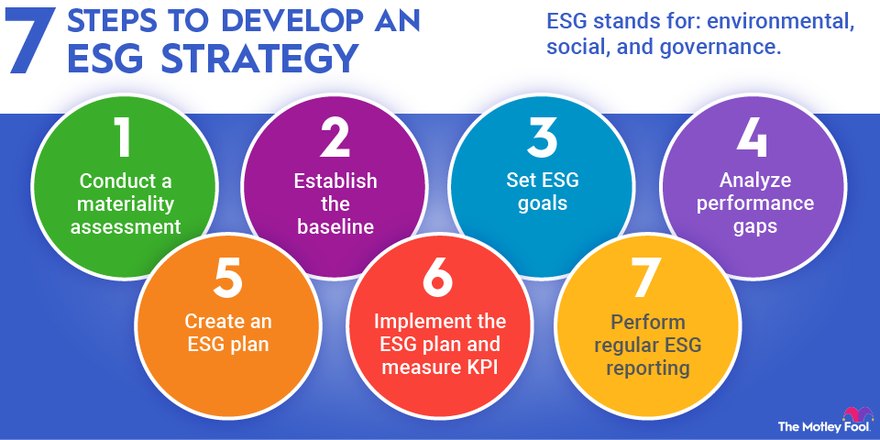An ESG strategy takes into account not only financial returns but also a company’s environmental, social, and governance risk factors. What if I told you that an ESG strategy could reduce costs and increase profits? That is precisely the reason more companies are using ESG as a business strategy.

Business has long revolved around the bottom line. Decades of experience have shown that it’s time to consider a triple bottom line. Measuring profitability by positive impact on people and the planet, as well as profits, is the new bottom line for a company’s sustainability.
Why consider an ESG strategy? Investors are looking for sustainable companies because it's good for business. Benefits include increased efficiency, lower costs, fewer supply chain or environmental risks, improved public perception, and increased market share. Here’s how to build an ESG strategy to do good while generating growth.
What is an ESG strategy?
ESG stands for “environmental, social, and governance.” ESG principles are used to quantify a company’s commitment to environmental sustainability, social responsibility, and good governance. While factors such as climate change and social injustice have increased public awareness around these issues, interest in ESG investing has been growing for decades.
For many investors, ESG analysis is now an essential step in their approach. Major hedge fund managers globally are supporting ESG-focused companies because it delivers results. Here are some highlights:
- ESG stocks, ESG ETFs, and ESG bonds are proving to be reliable, long-term investments as part of an ESG portfolio. The best long-term ETFs may indeed be those that screen for strong ESG companies.
- Over the last one-year, three-year, five-year, and 10-year timeframes, Standard & Poor’s 500 ESG Index has outperformed the broader S&P 500.
- Global ESG debt is nearing $5 trillion as reported by Bloomberg.
- Bloomberg projects ESG assets will account for more than one-third of global assets under management by 2025.
Business owners and CEOs should be taking notice. Benefits for businesses of all sizes usually boil down to better financial results. ESG strategies can improve efficiency and mitigate risk, leading to better performance.
An ESG strategy can also promote better community engagement or public perception, along with the satisfaction of reducing climate impact. The triple bottom line isn’t a fairytale; it is becoming the new paragon of business accomplishment worthy of investment dollars.
How to develop an ESG strategy
Applying an ESG strategy doesn’t have to be all or nothing. Consistent steps can lead to long-term changes. All successful ESG strategies have two common features: measurable, quantifiable action and results. Standard reporting frameworks provide a foundation for companies to develop a reliable ESG strategy.
The details of a corporate ESG strategy will be unique to each company and industry. The steps to define those details, however, are consistent.
Step 1: Conduct a materiality assessment
The materiality assessment should highlight ESG priorities for the company. The first question of a materiality assessment is: Who are the primary stakeholders?
If the purpose of an ESG strategy is to appeal to investors, they would be the primary stakeholders. In this case, the purpose may be to appeal to stakeholders with an interest in impact investing or sustainable investing.
The questions that follow are:
- What ESG metrics are important to the stakeholders?
- Why?
By answering the who, what, and why questions, a materiality assessment engages stakeholders to better understand the ESG issues to prioritize. A strong materiality assessment will include benchmarking exercises to assess a company’s ESG performance on specific indicators when compared to competitors and industry standards.
A company should look for a few outcomes of the materiality assessment:
- Define stakeholders and decide on target stakeholders for ESG priorities
- Gauge importance of environmental, social, and governance issues to stakeholders
- Gain insight into the company’s positioning on ESG relative to competitors
- Define current ESG priorities
- Highlight future reporting topics and actions
Step 2: Establish the baseline
Remember the measurable aspect of an ESG strategy? It starts here. If you cannot show investors where you were, it is difficult to measure progress. Some companies accused of greenwashing may have made significant steps but failed to take initial measurements.
The materiality assessment will highlight areas of focus, but measurements should be comprehensive to allow for future changes. Engaging third-party assessments will give an objective bird’s-eye view of current company performance.
This is the moment to consider using a standard reporting framework. The Sustainability Accounting Standards Board (SASB) was the gold standard for companies appealing to the “reasonable investor” with a variety of investment goals but whose primary objective is financial return. This now falls under the International Sustainability Standards Board (ISSB).
ISSB was founded in November 2021 to provide a “comprehensive global baseline of sustainability-related disclosure standards” for investors to assess sustainability-related risks and opportunities.
Companies can also consider other ESG disclosure standards, including the Task Force on Climate-Related Financial Disclosures (TCFD), Global Reporting Initiative (GRI) standards, and United National Principles for Responsible Investing (PRI).
If conducting the assessment independently, consider:
- Data systems
- Policies
- Accounting practices
- CEO pay
- Board diversity and voting rules
- Employee pay and benefits
- Work environment
- Community impact and engagement
- Total carbon emissions
- Water usage
- Waste management
With all of these, quantified performance is essential. For example:
- How many board members are non-white, female, LGBTQ+, disabled, or from another underrepresented group?
- How do employee pay and benefits compare to similar companies?
- What are the total water usage amounts and carbon emissions per year?
- How many breaches or security measures are in place on the data systems?
- Is the accounting independently audited?
- How are company ethics measured?
Step 3: Set ESG goals
Once the baseline is in place, it’s time to set ESG goals. Goals can include maintaining good performance, improving weak areas, and optimizing efficiency or overall performance. Engaging key stakeholders in the decision-making process can increase buy-in and improve results.
Some goals can include earning industry-specific certifications. An overall sustainability certification is a certified B Corp. Other goals could include moving the business into LEED-certified buildings or meeting sustainable development goals.
Environmental goals
Environmental goals will generally focus on reduced total carbon emissions, reduced waste, and reduced water usage. They can also focus on a shift to sustainable energy, improved operations, supply chain management, and overall efficiency.
Social goals
Social goals can include closing wage gaps, improved employee benefits, CEO pay, better working conditions, opportunities for advancement, and a safer work environment. Other social goals include giving back to the community, supporting social causes, and ethical raw material sourcing.
Governance goals
Governance goals include transparency in board structure, diversity, and decision-making. Data storage, security, and maintenance are often major factors in governance. Good accounting practices, financial transparency, and demonstrable business ethics also fall under governance.
Step 4: Analyze performance gaps
As with everything in business, it’s important to assess what’s working and what isn’t. This can include falling short on ESG criteria or major issues within the organization. A successful ESG strategy isn’t about getting it all right the first time; it’s about continuous improvement and assessing opportunities.
Analyzing gaps in ESG criteria highlights potential issues the organization could face while implementing an ESG strategy. The gap analysis will show you how far the company has to go to reach ESG integration targets and set reasonable time frames to make changes.
Step 5: Create an ESG plan
This is where you create a roadmap for ESG growth. This will guide ongoing ESG management. What can be accomplished right away? What is in the one-, five-, or 10-year plan? Breaking large ESG goals into a plan of actionable steps with realistic goals can lead to lasting organizational change.
If you haven’t started using a reporting framework, now is the time. Here are the major ones to consider:
These demonstrate commitment to third-party verification, transparency, and growth.
Related Investing Topics
Step 6: Implement the ESG plan and measure key performance indicators (KPI)
With the current state of the company defined and the roadmap in place, it’s time to start implementing ESG goals. Build in key performance indicators (KPIs) to assess progress.
Regular monitoring and updates are essential. Using a centralized management system or data software to track KPIs will make it easier to assess important metrics of sustainability.
In the spirit of Lean Six Sigma, ESG is about continuous improvement rather than a single change. Companies should continue to track KPIs and seek out improvement through the gradual shift of both culture and priorities.
Step 7: Perform regular ESG reporting
Using the above-mentioned frameworks and third-party assessment tools, plan a quarterly or annual performance report for key stakeholders. In the first report, it’s essential to highlight the policies and programs that are already in place and evaluate progress.
Reports can include organization-specific or industry-specific metrics, as well as evaluating engagement and progress across key metrics of sustainability. Earning additional certifications and hitting sustainability benchmarks will highlight further growth.
The bottom line
To remain competitive in the coming decades, companies will need to develop ESG strategies. Building an ESG strategy requires commitment to improvement and growth, but the payoff can be significant. Investor demand is driving the shift, but companies benefit in the long term.
With a few initial steps, the return for companies in both financial terms and in corporate responsibility can be more than worth the investment.




















